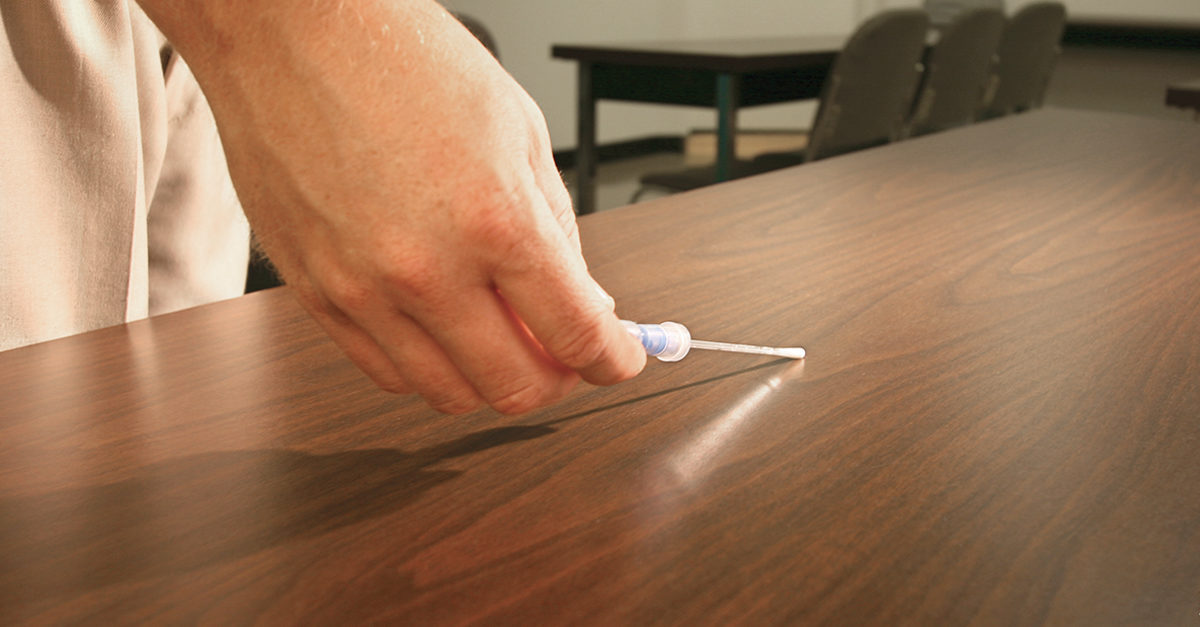A longtime veteran of the contract cleaning industry recalls many instances throughout the years where he would meet with prospects to bid on their cleaning needs only to be told that they were happy, if not very happy, with their current cleaning contractor. However, he was welcome to submit a bid.
Next, the contractor would conduct a walkthrough of the facility, and although he planned to submit a proposal, his own observation of the facility was that it did look clean and well-maintained.
Nowadays this contractor is ready for such situations and comes with some ammunition in hand. When the prospect says they are happy with their cleaning contractor, and although the facility does indeed look well-maintained, he takes out his handy adenosine triphosphate (ATP) rapid monitoring system and swipes a few counters, restroom fixtures, floors, door handles, and light switches. Showing the ATP results to the prospect—with some systems, results are available in 15 seconds or less—reveals that what was once believed to be a clean and well-maintained facility, may not be as clean or healthy after all.
This typically comes as a big surprise to the prospect when he or she understands what the ATP monitoring system is indicating. It’s a surprise to the cleaning contractor, as well.
Understanding ATP
ATP technology has probably been the most important system introduced to the professional cleaning industry to test potential contamination levels on surfaces before and after cleaning. The technology behind ATP is actually not new. It was introduced nearly half a century ago, and how it was discovered and how it works are actually quite surprising.
It all started by watching fireflies. Fireflies create light naturally due to a chemical reaction that depends on the presence of ATP in their bodies. ATP is found in all living organisms, so when a surface, such as a counter or restroom fixture, is swabbed and ATP is present, it is a good indication of potential germs, bacteria, or contamination.
Please note: We call it “potential contamination” for a reason. ATP detects living organisms on a surface, and while these organisms may not be harmful, when ATP is present and at high levels, it serves as a warning that contaminants may be present, too.
Contractors now use ATP technology for a variety of purposes, which includes bidding on facilities. Further, it can be used for employee training and evaluation. It is also used to evaluate cleaning effectiveness. For instance, we now know that some cleaning methods, specifically floor mopping, are not healthy cleaning procedures as a result of ATP testing.
ATP testing can also be used to evaluate new cleaning methods or technologies to warrant their effectiveness. For instance, when one manufacturer introduced a crossover floor-scrubbing system a few years ago, its first step was to have the system tested by a major university to compare its ATP readings to floor mopping and the use of traditional automatic scrubbers. In this case, ATP helped prove the new system was effective.
More Ways to Measure Cleaning
Believe it or not, before ATP, urine detection kits were used to swab surfaces and fixtures as a way to measure the cleanliness of an area. Although the urine of a healthy person is essentially sterile, when urine is present on surfaces such as floors, partitions, and counters, it often hosts potentially harmful germs and bacteria. This can also indicate that the urine, and potentially other organisms, were not properly removed.
Some additional ways to measure cleaning involve the following:
- Moisture detection systems. These systems are typically infrared measurement tools that look for hot and cold areas on a surface, such as a carpet. Colder areas can host moisture, which can cause mold, mildew, and bacteria to develop, harming indoor air quality. This can result from using too much moisture or not properly extracting moisture from a carpet after cleaning. If detected early enough, it can also help prevent damage to carpets, padding under carpets, upholstery, and other fabrics found in a commercial setting.
- Air quality testing kits. Some traditional cleaning products or procedures can be detrimental to indoor air quality. Several manufacturers make kits designed to test indoor air quality or to test for a specific allergen or contaminant. When using an air quality testing kit, cleaning contractors should take several measurements indoors as well as outside the facility to determine a baseline and to help determine the cause of indoor air quality problems.
- Effectiveness of preventative methods. As many cleaning contractors have experienced, should a slip-and-fall accident occur in a facility they clean, one of the first fingers of blame will be pointed at the contractor. This is why effective cleaning, or lack thereof, is closely tied to facility safety. To protect themselves and promote safety, cleaning contractors should select cleaning solutions and finishes as well as floor care equipment that helps to prevent slip-and-fall accidents. These tools have typically been certified as “high traction” by the nonprofit National Floor Safety Institute. High-traction tools either meet or exceed National Floor Safety Institute standards to help promote floor safety.
Setting Standards
It has been said that the use of ATP systems helped to develop cleaning standards. This is true of some of the other methods discussed here, as well. These technologies eliminate the guesswork in cleaning. Remember: When something looks clean, it no longer necessarily means it is clean.
Because our primary goal in the professional cleaning industry is to keep building users healthy, using cleaning measurement systems does not only measure clean, but also help us to develop standards that ensure cleaning effectiveness on a regular basis.



